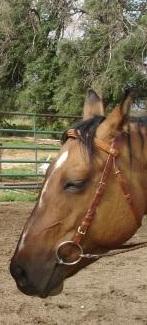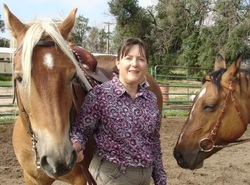 My Summer of Horses (see last week’s blog) pulled me into the world of Natural Horsemanship. Google this topic, and you’ll find plenty of websites and practitioners, so I’ll let you explore that on your own. My horse owner coworker Angie invited me just today to an event with Clinton Anderson (http://www.clintonanderson.com/). Earlier this month I attended a Parelli demo day with her and my granddaughter (http://www.parellinaturalhorsetraining.com/). When I went to the Parelli demo, I learned the new philosophy of horse training based on the horse’s psychological makeup. Horses are prey. We are predators. Allowing a human to leap onto its back goes counter to a horse’s survival instincts. Using your human brain to encourage cooperation from a horse works much better than physical coercion of an animal 5 to 10 times our size. The new philosophy is humane, with an emphasis on equine and human safety. A scared, angry, or frustrated horse is dangerous. As a kid, I was influenced by farmers and cowboys who insisted that if a horse didn’t do what you wanted, you had to make it behave. Not easy for a skinny little girl, so I liked hearing about this new philosophy of horse training. But how new is it? We tend to believe that our generation (choose whichever applies) is the innovator of all that is good and beautiful. News Flash. According to the Society for the Prevention of Cruelty to Animals International, the first Society “was organized in England in 1824, primarily to prevent the abuse of carriage horses in the days before automobiles.” (http://www.spcai.org/about/our-history.html) The first US SPCA was founded in 1866. From Black Beauty (by Anna Sewall, published in 1877) to the War Horse (by Michael Morpurgo, published in 1982), fiction writers have documented the potential positive and negative aspects of the human-horse relationship. Kind treatment of horses is not new. There have always been “horse whisperers.” Even so, the “new” philosophy of Natural Horsemanship is a wonderful development. The best way to gain the cooperation of a skittish animal capable of stomping you to bits is through firmness tempered with kindness. Always has been – always will be. But now we have websites, dvds, and events galore to guide us. 8/12/2013 Cowboy Sam and the Summer of Horses Life doesn't get much better than this. Catherine with Taz and Sage. Life doesn't get much better than this. Catherine with Taz and Sage. I have photos of myself dressed in a cowgirl hat and vest at age three or four. The first books I remember (after Hop On Pop and the Dick and Jane series), were early readers with cowboys and horses as the main characters. I can’t say my love of horses was anything my parents particularly encouraged. My three siblings had no more than a passing interest in all things equine. In my family, horses were definitely my thing, while the rest of the kids pursued other hobbies. As a teenager and into my early twenties I owned horses. Or should I say, my parents enabled my horse habit. My husband’s family had horses too, until he and his brother discovered motorcycles. As an adult, limited time and money have curtailed my ability to own horses. I rented a horse for a trail ride here and there. It wasn’t the same. I pursued a lot of other outdoors activities, but I always felt a little tug in my heart when I drove by a pasture full of grazing horses. Then my twelve-year-old granddaughter attained the Age of Horses that many young ladies go through. She started riding lessons three years ago. Due to schedule issues for her parents, it appeared she would miss lessons this summer. I jumped in to offer my chauffeuring services. And as long as I was at the stable, I might as well take lessons, too. We became a team of four, as the eight-year-old granddaughter, and my home-for-the-summer college student stepdaughter expressed interest in lessons. Lara came recommended by a coworker. What you need to know about Lara is that she’s a real cowgirl. This is not the kind of stable where the instructor brings a groomed and saddled horse to you. Included in the lesson is brushing, cleaning hooves, lifting the heavy saddle onto the horse, and in general getting your hands dirty while getting a workout. My older granddaughter even went into the pasture to round up horses. Only after this does the lesson start. Lara gives praise when it is earned. Under her expert guidance, you must be truly dense or inept to not learn, and so the praise does come eventually. She managed to end most lessons on a high note, after the student finally demonstrated a technique. I consider the Summer of Horses as research for my short stories and novels involving cowboys and cowgirls, donkeys and horses. Write what you know? I grew up around the genuine article, and we have family and friends who qualify if you count New West editions. Real cowboys and cowgirls still exist, but they have changed with the times. And that’s a good thing. One of the most welcome changes is the theory of natural horsemanship. I’ll talk more about that in my next blog. Until then, who remembers the early reader series Cowboy Sam by Edna W. Chandler? |
Subscribe to this blog: |
Proudly powered by Weebly
 RSS Feed
RSS Feed